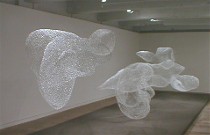
A panel discussion on public art organized by Penn’s Department of Design drew me into Fleisher-Ollman Gallery, which was a lucky thing, because one of the speakers, sculptor Mei-Ling Hom, whose work I have often admired, had a show up in the gallery.
Hom, who has a long history of creating work about identity, and especially her own as a Chinese-American woman, was showing clouds–clouds made of chicken wire (left), clouds of stone (right), clouds of rubber, and clouds of felt.
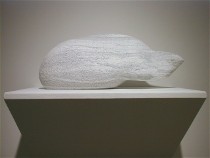 The wows of the show are the clouds of chicken wire, a medium Hom has used to great effect in the past, making rather architectural, controlled shapes. (I don’t know if you’ve ever worked with chicken wire, but it’s kinda snarly, and her level of control and craftsmanship is extraordinary.)
The wows of the show are the clouds of chicken wire, a medium Hom has used to great effect in the past, making rather architectural, controlled shapes. (I don’t know if you’ve ever worked with chicken wire, but it’s kinda snarly, and her level of control and craftsmanship is extraordinary.)
These clouds retain the control but lose the architecture. They are puffy, erratic cloud shapes.
And I can’t help but think that they must also reflect something of Hom’s identity.
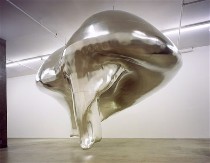 The clouds also brought me back to some work I saw last year at Max Protetch in New York by Inigo Manglano-Ovalle of fiberglass and titanium alloy foil. This force of nature, (shown, “Cloud Prototype #1”) is a scale model of a 30 km.-long cumulonimbus thundercloud based on actual storm database.
The clouds also brought me back to some work I saw last year at Max Protetch in New York by Inigo Manglano-Ovalle of fiberglass and titanium alloy foil. This force of nature, (shown, “Cloud Prototype #1”) is a scale model of a 30 km.-long cumulonimbus thundercloud based on actual storm database.
The Manglano-Ovalle’s huge piece (132 x 176 x 96 inches), a literal translation of nature, was a reminder of the size and power of atmospheric forces.
Hom’s clouds are not literal, and they are a reminder of human nature.
As for the cloud imagery in general, I suppose it reflects our need to get beyond war and contention and destruction, which have taken over nature and may well be destroying it. The clouds, at least, seem unruffled by the affairs of man.
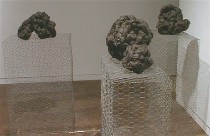 As for the stone clouds, Hom said, she wanted to see if she could imply the airiness of a cloud in a material that is utterly concrete. The little two-ton puffs made me think of dollops of whipped cream rather than clouds–still filled with air by not quite vaporous. The reductive modernism of these pieces, a la Brancusi, was surprisingly classical.
As for the stone clouds, Hom said, she wanted to see if she could imply the airiness of a cloud in a material that is utterly concrete. The little two-ton puffs made me think of dollops of whipped cream rather than clouds–still filled with air by not quite vaporous. The reductive modernism of these pieces, a la Brancusi, was surprisingly classical.
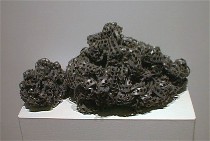 But classicism is not my personal taste. What interested me, besides the chicken wire were the black knotty pieces Hom twisted into cloudlike forms. The felt ones (above right) looked like wigs as well as storm clouds that had contracted in on themselves until the vapor turned solid. The black rubber (left) reminded me of playground equipment, something to bounce on and climb over–not a cloud but still something with an inner bouyancy.
But classicism is not my personal taste. What interested me, besides the chicken wire were the black knotty pieces Hom twisted into cloudlike forms. The felt ones (above right) looked like wigs as well as storm clouds that had contracted in on themselves until the vapor turned solid. The black rubber (left) reminded me of playground equipment, something to bounce on and climb over–not a cloud but still something with an inner bouyancy.









